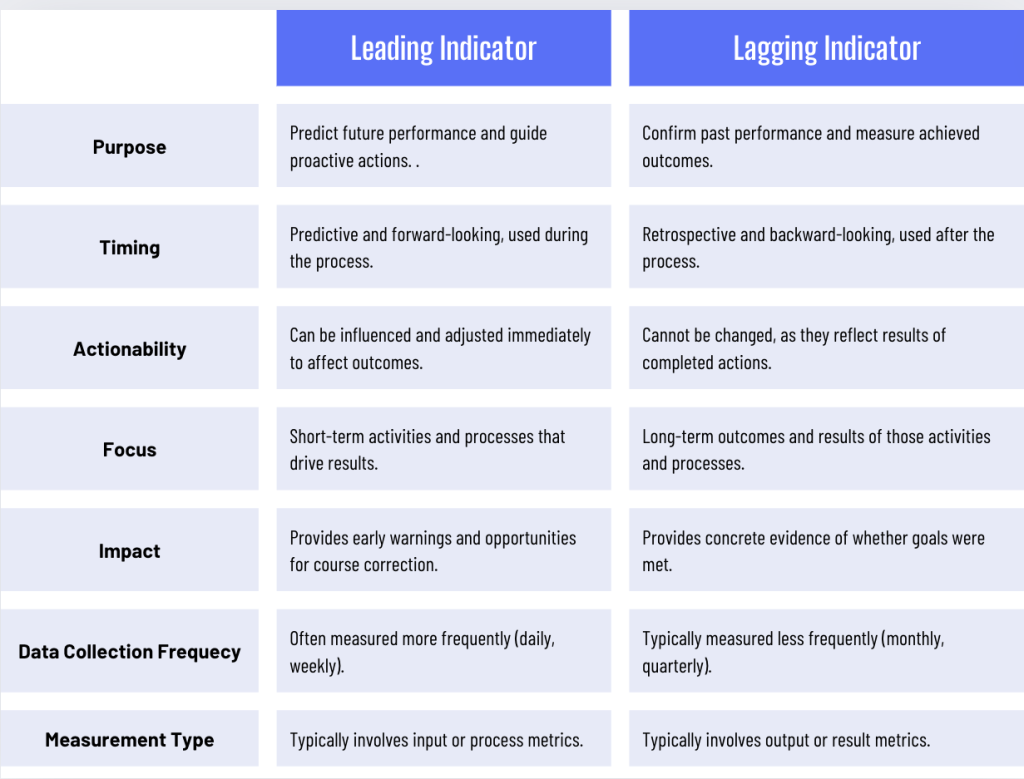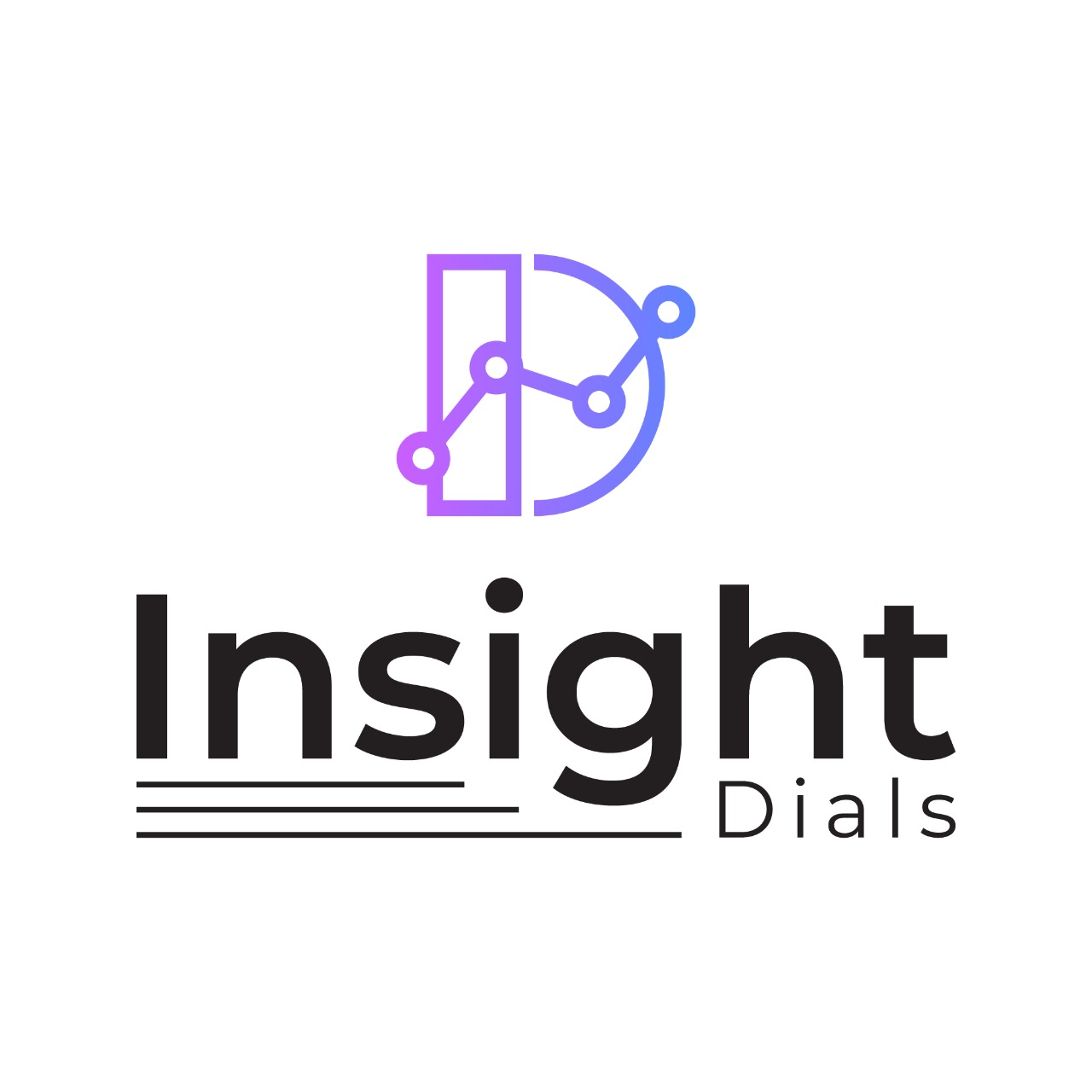
In the realm of business analytics, the ability to forecast and measure performance is paramount. Companies thrive on making informed decisions that propel growth and mitigate risks. This is where the concepts of leading and lagging indicators come into play. Understanding and effectively utilizing these indicators can be a game-changer for any business seeking to stay ahead of the competition and ensure long-term success.
What are Leading and Lagging Indicators?
Leading Indicators
Leading indicators are predictive metrics that provide early signals about future performance. They are proactive and forward-looking, offering insights that can help businesses make adjustments before trends and outcomes fully develop. These indicators focus on activities and processes that influence future results, allowing organizations to anticipate changes and adapt accordingly.
Example of Leading Indicator
Scenario: Launching a New Product with High Adoption Rate
Here’s an example where a company aims to launch a successful new product within nine months.
Goal: To achieve a 30% adoption rate of the new product within the first three months post-launch.
- You have nine months to prepare for the product launch.
- Target market size is 10,000 potential users.
- Your goal is a 30% adoption rate within three months post-launch.
Leading Indicators: To ensure you’re on track for a successful product launch and achieve the desired adoption rate, focus on leading indicators that reflect product readiness, market interest, and pre-launch engagement.
- Product Development Milestones
- Customer Feedback during Beta Testing
- Marketing Campaign Engagement
- Pre-Launch Sign-Ups
Step-by-Step Approach:
Set Targets for Leading Indicators:
- Product Development Milestones:
- Complete prototype by month 3
- Beta testing by month 6
- Final development by month 8.
- Customer Feedback during Beta Testing:
- Achieve an 85% satisfaction rate
- Address critical feedback by month 7.
- Marketing Campaign Engagement:
- Achieve a 25% email open rate
- 15% click-through rate
- 500 webinar attendees.
- Pre-Launch Sign-Ups:
- Secure 2,000 pre-launch sign-ups by month 8.

Analysis
After the Leading Indicators are set Monitor and Analyze these Metrics by conducting monthly meetings to review product development progress and beta testing feedback. Also, bi-weekly assess marketing campaign engagement and pre-launch sign-ups to identify gaps or trends.
As needed Adjust Strategies to achieve the goals. If product milestones are delayed, allocate additional resources or adjust project timelines. Also, if beta feedback is negative, prioritize critical improvements and retest with a select group of users. If engagement metrics are low, refine marketing strategies, increase promotional activities, and explore new channels. High marketing engagement and pre-launch sign-ups indicated strong market interest and readiness for adoption.
By consistently tracking and analyzing these leading indicators, you can ensure that your team remains proactive and aligned with the overall goal of achieving a high adoption rate for the new product within the first three months post-launch. This approach allows for timely adjustments and sustained focus on activities that drive success.
Lagging Indicators
Lagging indicators, on the other hand, are retrospective. They measure the outcomes and results of past actions and decisions. These indicators provide a clear picture of performance but do not offer predictive insights. While they are essential for evaluating success and identifying areas for improvement, they do not help in forecasting future performance.
Example of Lagging Indicator
Scenario: Evaluating the Success of a New Product Launch
Here’s an example where a company aims to evaluate the success of a new product launch by using lagging indicators.
Goal: The goal is to achieve a 30% adoption rate within the first three months post-launch.
- The target market size is 10,000 potential users.
- Your goal is to achieve a 30% adoption rate within the first three months post-launch.
- Customer satisfaction should be at least 80%.
- Aim to generate $500,000 in revenue and achieve a positive ROI.
Leading Indicators: To measure the success of the product launch, focus on lagging indicators that reflect actual performance outcomes and customer reactions. Here are a few key metrics to consider:
- Adoption Rate
- Customer Satisfaction Scores
- Revenue Generated
- Return on Investment (ROI)
Step-by-Step Approach:
Collect Data for Lagging Indicators:
- Adoption Rate:
- Measure the number of users who have adopted the product out of the total target market.
- For example, if you have set a Target: 30% and the actual achieved is 28%. Shows its slightly below target, indicating strong but not optimal market penetration.
- Customer Satisfaction Scores:
- Use post-purchase surveys, online reviews, and direct customer feedback to measure this.
- For example, if the Target: 80% and the actual achieved is 85%. Shows it exceeds target, indicating high customer satisfaction and positive reception.
- Revenue Generated:
- Track sales data and total revenue.
- Example if the Target: $500,000 and the actual achieved is $475,000. Shows its slightly below target, suggesting the need to boost sales efforts or reevaluate pricing.
- ROI:
- Calculate the total costs incurred and the financial return from product sales.
- Example if the Target: Positive ROI but the actual achieved is 15% ROI. Shows its positive but lower than expected, highlighting areas for cost optimization or additional revenue streams.

Analysis
Once you have tracked the numbers, Analyze Performance by conducting monthly reviews to analyze collected data and compare with targets. Identify trends and patterns in the data to understand the overall success of the launch.
Make Data-Driven Adjustments like Product feature enhancements based on customer feedback, to improve user experience and satisfaction. Optimize Marketing Strategies to address any gaps in reaching the target audience. Increase targeted marketing campaigns and promotional offers to boost adoption and revenue. Adjust Pricing if revenue targets are not met, consider adjusting pricing strategies to enhance sales. Introduce tiered pricing options to attract more customers and increase sales.
By focusing on these lagging indicators, you can evaluate the overall success of your product launch and identify areas for improvement. This approach allows you to make data-driven adjustments to enhance future performance and ensure long-term success.
Comparison of Leading & Lagging Indicators
Understanding the distinction between leading and lagging indicators is essential for effective performance management. While leading indicators help predict future outcomes and guide proactive actions, lagging indicators confirm past performance and measure the success of those actions. Together, they provide a comprehensive view of an organization’s progress and effectiveness.
How They Work Together
Scenario: Sales Performance
Goal: Increase sales revenue by 20% over the next quarter.
Leading Indicators (Predictive and Actionable):
- Number of Sales Calls: Tracking how many calls sales reps make can predict future sales.
- Sales Pipeline Volume: The total value of potential deals in the pipeline.
- Customer Meetings: Number of face-to-face or virtual meetings with prospects.
Lagging Indicators (Confirmatory and Result-Oriented):
- Total Sales Revenue: The actual revenue at the end of the quarter.
- Number of Closed Deals: The total number of deals closed.
- Customer Retention Rate: Percentage of customers who continue to buy.
The Relationship:
- Leading Indicators Track Progress: As you monitor the number of sales calls and pipeline volume, you can predict whether you’re on track to meet the revenue target. These indicators guide daily activities and short-term strategies.
- Lagging Indicators Confirm Results: At the end of the quarter, total sales revenue and the number of closed deals will confirm whether the sales strategies and activities (tracked by leading indicators) were successful.
Key differences between Leading & Lagging indicators:

Conclusion
In conclusion, you are missing out on the full metric picture if you are using lagging indicators without leading indicators. The strategic integration of leading and lagging indicators is vital for effective performance management. Leading indicators offer early insights and guide proactive adjustments while lagging indicators validate the outcomes of those efforts. By leveraging both, organizations can navigate real-time challenges, ensure alignment with long-term goals, and continuously refine their strategies for sustained success. This balanced approach enhances decision-making and agility and provides a comprehensive understanding of overall performance, driving continuous improvement and growth.


